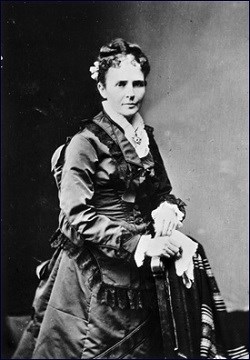|
“May the glorious thought console me, that there is a land where friendships are never dimmed and partings never come.” — James A. Garfield, June 23, 1854 
about as much use to stop breathing as to let books alone if they are anywhere in the region about me. I have to read ... as I have to live.” National Park Service Malaria: The Evil Spirit of the White HouseIt came on quietly … stealthily …
The week before, First Lady Lucretia Garfield managed and attended several social obligations: dinners, teas, receptions and overnight guests. Her husband even assisted: “April 1881 – Tuesday, 26. Helped Crete at her reception in evening.”
By May, it was ominous …
“May 1881 – Tuesday, May 3. In the evening, helped Crete in receiving her friends in the red parlor. Poor Crete, she is not well—malaria, almost a chill this morning.” Murat Halstead, a newspaper editor, called on the first family and found Mrs. Garfield huddled by “a rather unseasonable wood fire.”
“Wednesday, 4. Crete has been ill all day with something like chill fever. She has been too hard worked during the past two months.” “Thursday, 5. Crete has been in bed all day with a bad fever.” By Saturday, May 7, President Garfield had arranged for his wife’s physician, Dr. Susan Edson, to stay with her and kept the room very quiet in hopes of a speedy recovery. A couple days later when the first lady was suffering a great deal of pain, the president “wanted the judgment of a fresh mind on her situation” and sent for Dr. Jedidiah H. Baxter, whose duties included serving as personal physician to the President of the United States and attending to his family. He agreed that it was the result of malaria and overwork but feared there might be danger of cerebrospinal meningitis. 
father’s home on November 11, 1858. National Park Service The president was consumed with worry.
On May 11, 1881, Washington newspapers began commenting on the illness of the first lady. The front gates of the White House were closed to visitors. No carriages were allowed to approach to keep the area quiet. A reporter for the Washington Star wrote, “It is now believed that Mrs. Garfield’s illness was wholly due to the effects of sitting so long in the hot sun the day the Farragut statue was unveiled.” The first lady’s malaria was followed across the country in headlines and editorials, always with a focus on President Garfield and his anguish. “My anxiety for her dominates all my thoughts and makes me feel that I am fit for nothing,” he told his friend Henry Knox. “If I thought her return to perfect health could be insured by my resigning the presidency, I would not hesitate a moment about doing it.” The president’s cousin, Dr. Silas Boynton – a homeopath – finally arrived in mid-May to take over her care. He administered heroic doses of potent medicines to alleviate her high fever. On Saturday, May 14, the fever dropped to 101 degrees and fell further on Sunday. The next day, she relapsed into weakness and fatigue – but the fever did not rise. Crete’s improvement was very, very slow, but Dr. Boynton felt that it was moving in the right direction. Fortunately, cooler weather seemed to help her recovery. Lucretia’s strength was increasing, and she asked to be lifted from bed into a lounge chair on May 28. 
In the house: Drinking Horn/Hunt TrophyWe get a lot of questions about this unique item. In 19th century Europe, these horns were awarded as “trophies” for hunting expeditions and proudly displayed on bookcases, desks, or fireplace mantels. Also known as “drinking horns,” the vessels were used for toasting before and after the hunt. The Garfields most likely enjoyed the decorative piece for its aesthetic value.
Style: French Renaissance
Materials: Horn, Brass, Tin (liner)
Date: c. 1880 - 1895
Location: James A. Garfield National Historic Site, Memorial Library
Monthly events
May 11 at noon at Mentor Public Library: Leaders & Legacies of the Civil War Era: “At the Home Front with Mrs. Lucretia Garfield.” Please join Mrs. Lucretia Garfield for family stories about life in Hiram, Ohio during the Civil War. June June 8 at noon at Mentor Public Library: Leaders & Legacies of the Civil War Era: James A. Garfield and the First Decoration Day (Encore). The late-May holiday we call Memorial Day began after the Civil War and was then known as Decoration Day. Learn more about Decoration Day and Garfield’s powerful speech that day. Call the library at (440) 255- 8811 for reservations. June 9 at 7:30 p.m.: The University Heights Symphonic Band will perform an outdoor concert on the lawn. Bring your own lawn chairs and picnic. (Alcohol is not permitted.) June 11 at 10 a.m.: In honor of the upcoming Flag Day on June 14, join members of local Boy Scout troops as they properly and respectfully retire used American flags. Visitors are encouraged to bring flags they would like to have retired or drop those flags off at the site in the days before the ceremony. Free |
Last updated: May 4, 2022
